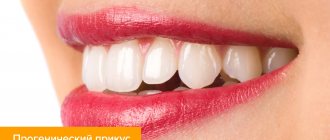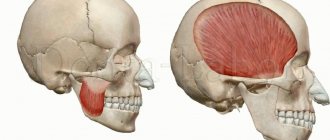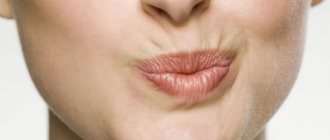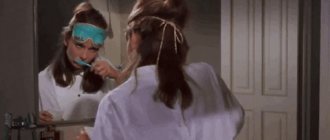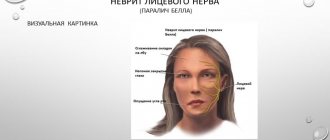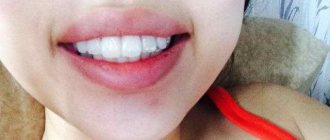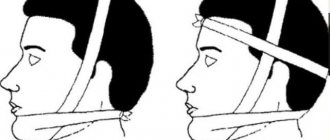If you are concerned about facial asymmetry:
- Don't rush to see a surgeon!
Any surgical intervention is a risk. Especially if the operation does not eliminate the cause of the problem.
- Don't rely only on cosmetics!
You can paint and repaint a damaged car as much as you like. But that won’t stop her from being beaten. It's the same with the face...
Treatment at the Orto-Artel clinic without surgery!
We will help you understand the correction of facial asymmetry. And we will decide “wisely”, based on the reason.
Problems of facial aesthetics are of more and more concern to our patients. “How to correct facial asymmetry?”, “How to correct an asymmetrical face?” or “If the face is not symmetrical, what should I do?” We hear such questions very often. But how is this usually solved in other clinics? Cosmetologists, plastic surgeons. And all of them are in demand and promise good results. But is turning to a surgeon always justified? And can a cosmetologist always help? And most importantly, is there an alternative to surgery and all these “Botox”, “golden threads” and other “medicines” for the face? Indeed, very often, in pursuit of aesthetics, wanting to get results here and now, patients forget about the main thing - health.
Treatment in installments
The Orto-Artel clinic offers installments for the entire process of treating any disease. Personal conditions are considered on an individual basis.
Find out more
or call 8 (495) 128-11-74
One of the most common problems is various types of facial deformities. The range of such asymmetries, as well as complaints and tasks that patients set for themselves in order to achieve a harmonious face, is very diverse. Some people don't like the fact that the right and left halves of the face are not the same. Someone is concerned about different eye sizes (see “Deformation of the cranial bones”). Someone has an asymmetrical jaw: the lower jaw moves to the side when opening the mouth, or the center of the upper jaw (the line between the central upper incisors) is shifted to one side (see “Crossbite”). And some people have ears at different levels and protruded differently. Someone’s jaw protrudes (see “Mesial bite”) or, conversely, “sinks” (see “Distal occlusion”). And someone has an asymmetrical chin.
In general, our patients have a great many complaints and complaints. But, despite this variety of expression and manifestations of facial asymmetries, these problems are corrected, as a rule, for some reason very superficially: either cosmetologists “inject”, “pump” or “rub” something, or surgeons do plastic surgery, something cutting or enlarging.
But it should, however, be understood that an asymmetrical face is not a diagnosis. This is just a symptom of a problem. A symptom, in medical terms. But treating symptoms is a thankless task. It is much more important to find the cause of the problem and eliminate it.
Diagnostics is the first and key step in the treatment of facial asymmetry. Do you want to know why it’s impossible to do without diagnostics?
Symptoms of facial asymmetry
The severity of facial asymmetry and the reasons that led to the appearance of defects are the two main factors on which the clinical picture of the pathology depends. Minor violations that occur due to age-related changes are considered to be only an aesthetic problem. Gross disproportion of the facial part of the body is usually observed after severe injuries or serious illnesses. Symptoms of changes on the side of the injury are easy to notice externally:
- facial muscles are not involved in movements;
- the corner of the mouth drops;
- articulation is impaired;
- natural folds on the forehead and in the area of the nasolabial triangle are smoothed out;
- the patient cannot completely close one eye;
- while eating, the work of the lacrimal glands increases;
- there is no facial expression on one side of the face.
Correction methods
Treatment is prescribed depending on the cause and severity; these are cosmetic, orthodontic, conservative or surgical methods. In some cases, therapeutic exercises and massages are indicated.
Cosmetic procedures are indicated for hypertonicity and involve the injection of Botox-based drugs into the muscle area. They relieve stress, give the face a confident, calm expression and restore visual symmetry.
Therapy using conservative methods involves treating root causes such as pulpitis, periodontitis and others. To do this, antibiotics are prescribed to eliminate the infection, analgesics for severe pain, antiseptics and other drugs. The dosage regimen and medications are selected based on diagnostic data.
Massage is performed in rare cases; it is usually part of complex therapy and allows you to solve the following problems:
- relieving hypertonicity or swelling, toning, muscle relaxation;
- elimination of pain syndrome;
- nerve stimulation;
- activation of blood supply to tissues.
Manual therapy will be effective in childhood and in the early stages of diagnosing the problem. In other situations, there will be little benefit from massage.
Orthodontic correction methods help with malocclusions. For therapy, splints, braces, removable or fixed devices are used. If they do not show effectiveness, surgical treatment is prescribed, divided into the following types:
- dental (opening of suppuration, removal of affected tissue);
- otolaryngological (ectomy of formations in the form of cysts);
- maxillofacial (removal of phlegmon, lavage, endoprosthetics);
- to eliminate complications after injuries (bone tissue regeneration, splinting, tying with a ligature).
Complications
The complexity of the consequences depends on the degree of pathology, corrective measures taken and other reasons. In some cases, the problem can be quickly eliminated with a small correction or cosmetic methods. But in case of complications, surgery is necessary, since destruction of the TMJ is likely. Risks also include dysfunction of the dentition and the formation of malignant tumors. Complications develop in the absence of contact with a doctor, non-compliance with the treatment regimen, or complete ignoring of the problem. Over time, the situation worsens and becomes more difficult to correct.
Prevention
To eliminate complications and the development of the problem, the following preventive measures are recommended:
- daily brushing of teeth using special brushes and pastes;
- removing food debris with irrigators;
- eradication of bad habits, teaching the child the features of oral hygiene;
- Regular visits to the dentist to monitor the condition and timely treatment.
A nutritious diet and giving up bad habits, such as smoking, are mandatory. When wearing mouthguards, you should refrain from eating solid food to eliminate the risk of jaw row injuries.
Stages of development of facial asymmetry
- First stage. The functionality of the facial nerve is preserved, no significant changes are observed.
- Second. A slight curvature appears when a person closes their eyes or smiles. The patient has weakness of the facial muscle tissues.
- Third. Signs of asymmetry are more pronounced, difficulties appear in raising the eyebrows, muscle mobility is partially limited, and there may be spasms.
- Fourth. The face becomes asymmetrical even at rest, the eye does not cover completely, and the position of the mouth is disturbed.
- Fifth. The main sign is the absence of contracture; movements of the injured side are imperceptible.
- Sixth. Muscle tone decreases, the patient complains of the inability to move the muscles of the affected part of the face.
If any signs indicating a violation of the symmetry of the front sides appear, it is recommended to consult a specialist.
Causes
Asymmetry can be detected at any age; usually in the early stages, the problem is identified after the birth of the child, two to three days later. At this time, the skull should already have taken on a normal shape, so the violation will be noticeable immediately. The causes of this phenomenon are birth injuries. If parents do not follow the recommendations for caring for the baby, there is a likely risk of developing asymmetry due to the child being constantly in one position. Such problems do not require serious intervention; they are usually eliminated by massage.
Most often, asymmetry is caused by the following congenital reasons:
- congenital anomalies;
- muscular dystonia, accompanied by impaired muscle contractions, development of TMJ, crossbite;
- hypertonicity of the muscular frame;
- the presence of clefts in the upper lip, causing the formation of a hollow in the middle part of the face;
- malformations during pregnancy;
- congenital anomalies;
- pathologies of skeletal development.
Acquired factors include:
- bite problems that develop due to poor nutrition, bad habits and other reasons;
- defects of the temporomandibular joint;
- tumors that form in the jaw area (osteoma, various types of odontoma, salivary stones);
- injuries to muscle and bone tissue, including bone fractures;
- impacted units;
- periostitis;
- trauma during childbirth;
- inflammatory processes affecting the periodontium.
In addition, the causes of asymmetry can be nerve paresis, curvature of the spinal column, and diseases of the ENT organs. In adult patients, these factors are:
- congenital problems that were not corrected in childhood;
- ankylosis of the joint, accompanied by degradation of cartilage tissue;
- arthrosis, dystrophic changes;
- limited movement of the muscles of the lower jaw;
- formation of benign or malignant tumors;
- various defects of the jaw system;
- damage, underdevelopment of the VN or LF;
- diseases affecting the salivary glands;
- purulent processes in the periosteum;
- abscesses in the area of the tooth root;
- cross bite.
Provoking factors for the development of asymmetry include:
- damage to brain tissue and membranes;
- cysts in the sinuses;
- adenomas;
- botulism;
- poisoning with certain chemicals;
- purulent mumps and others.
Prices
| General: | |
| Initial consultation with a dental specialist (30 min.) | 2,300 rub. |
| Extended consultation with a dentist, head of Orto-Arteli | 6,000 rub. |
| Consultation with a dentist with a description of the CT scan, drawing up a preliminary examination and treatment plan | 5,000 rub. |
| Spot X-ray | 650 rub. |
| Diagnostics: | |
| Primary diagnosis (two visits) First visit: taking impressions, making plaster models, photos. Analysis of jaw models, multisystem analysis of lateral TRG, OPTG analysis, photometry, diagnosis, development of a treatment plan. Second visit: announcing the results to the patient and discussing the treatment plan with him | from 30,000 rub. |
| Additional diagnostics | from 40,000 rub. |
| Diagnostics in the articulator | from 8,000 rub. |
| Computer cephalometry with axiography | 25,000 rub. |
| TENS | 8,000 rub. |
| Analysis of TRG in direct (frontal) projection | 5,000 rub. |
| TRG analysis in the genioparietal (SMV) projection | 5,000 rub. |
| Postural diagnostics Read more about diagnostics in our clinic | |
General information
Jaw asymmetry is a pathology expressed in visually visible asymmetry of the lower third of the face. Displacement away from the midline of the entire upper or lower jaw, their segments or individual areas of the face - lips, chin, branches of the upper and lower jaw.
In addition to the above features, pathology can manifest itself as drooping corners of the lips, disruption of the oval of the face, widening or narrowing of the eyes, smoothed lip folds, and some specific features, for example, a pained expression.
To see whether there are deviations or not, you need to imaginarily draw the central line of the face - a vertical straight line passing strictly along the space between the central incisors of the upper and lower jaw. A wide smile makes asymmetry more pronounced.
Strictly speaking, there is no complete correspondence between the left and right parts of the face (ideal symmetry). A certain disproportion of them is present in all people.
The physiological norm is considered to be a position in which the asymmetry in the linear value does not exceed 2-3 mm, in the angular value - 3-5°. If these values are exceeded, they talk about pathology and look for the reasons for its occurrence.
To a greater extent, asymmetry is characteristic of the lower jaw. This is explained by the fact that it is located movably relative to the skull, and has more factors influencing its position than the upper jaw. This is the type of bite, the condition of the TMJ, habitual postures, manner of chewing food, etc.
Dental problems solved with mandibuloplasty and the results achieved.
Come here if you are wondering why your jaw clicks when chewing.
According to this address https://orto-info.ru/zubocheliustnye-anomalii/chelyustey/smeshheniya-sredney-linii.html we will discuss how to correct the displacement of the midline of the teeth.
Visual reduction of the face
As for a deep bite, its characteristic feature is the overlap of the lower incisors with the upper incisors by more than half (while the norm is one third). However, this may apply not only to the incisors, but also to the lateral teeth. With such a bite, the face appears flattened from below, and the lower lip often turns outward, since it has nowhere else to go. If the owner of a deep bite does not have a very high forehead, then the face looks very small, but if the forehead is high enough, then the disproportion of the upper part of the face relative to the lower becomes noticeable. If a person gets into the habit of pursing his lips (to avoid turning out the lower one), then the lips will appear thin, which will visually make the face appear even smaller.
Diagnostic measures
The first doctor you should contact if an abnormality is noticed should be a dentist or neurologist. If you need to connect a doctor of another specialization to the diagnosis - an otolaryngologist, an oncologist, a neurosurgeon - the first receiving doctor will refer the patient to them.
Cosmetologists also claim to be the first to visit, claiming that in case of facial asymmetry caused by hypertonicity of the masticatory muscles, cosmetic procedures alone may be sufficient to solve the problem.
The list of dental diagnostic measures is as follows:
- Survey . The patient's complaints are listened to and the medical history is clarified.
- Physical examination . The degree of anomaly at rest and movement is assessed, probing, palpation and percussion are performed. The clinic of the dentofacial apparatus is assessed (presence of edema, tumors, suppuration, consequences of injuries, condition of the teeth).
- X-ray of the jaws . Photographs of individual teeth, dentition (orthopantomography and teleradiography) and nasal sinuses are taken. If necessary, radiographs of the skull and spine in the neck area are obtained.
- Ultrasound examination. Sonography of sinuses, tissues, salivary glands.
- CT or MRI. Used for detailed study and clarification of symptoms obtained by radiography.
- Orthodontic examination . Cephalography, determination of bite, occlusion, presence of supercontacts, analysis of diagnostic models in the articulator, etc.
When doctors of other specializations participate in the diagnosis, the following examinations may be carried out:
- From a neurosurgeon . A CT scan of the brain is done.
- See a neurologist . The innervation of the facial muscles is checked - by wrinkling the forehead, puffing out the cheeks, raising and lowering the eyebrows, and following the doctor’s movements with the eyes. The exit points of the nerves are palpated.
- See an otolaryngologist . Special examinations are carried out - diagnostic puncture, echosinusoscopy, tuning fork examination, audiometry.
If necessary, general laboratory tests are performed. The blood is examined for the presence of inflammation and bacterial infection. Cytological and histological analysis of punctates and smears is carried out.
Based on the diagnostic results, a conclusion is made about the causes of the anomaly, and a treatment plan is drawn up.
Is it worth correcting an overbite?
Despite the fact that correcting a bite in adults is more difficult and takes more time than similar manipulations in children, believe me, it is worth it. Indeed, in addition to all of the above purely aesthetic deviations in the structure of the face caused by abnormal closure of the teeth, there is also a risk of dislocation of the lower temporomandibular joint and curvature of the spine. Subsequently, this leads to various problems: chewing food becomes more difficult, bruxism and “clicking” of the jaw occur, pain in the neck and back appears, headaches begin to bother you, the frequency and intensity of dental diseases increases, speech deteriorates, and as a result of all this, self-esteem and ability often decrease. to communication. Therefore, it makes sense to think about seeking help from an orthodontist - a specialist who diagnoses, prevents and treats dental anomalies using braces and other devices, and in case of serious violations, will send for surgery to correct the bite. In addition to significantly improving the quality of life, relieving pain, eradicating speech defects and improving the dental condition of the oral cavity, correcting the bite will return symmetry and proportionality to the face, eliminate inappropriate “frozen” expressions on the face, and also help avoid early aging of the skin and facial muscles, which will make you objectively more attractive.
1.General information
The face of a living person is almost always slightly asymmetrical, i.e. the right and left parts are slightly different in shape and/or size.
This is partly explained by the natural individual characteristics of the location of the subcutaneous soft tissues, and partly by the manner of facial reaction that is familiar to humans and therefore no longer noticeable. But sometimes the asymmetry is so pronounced that it becomes not only a cosmetic, but also a medical problem, because it disrupts a number of essential functions. At the same time, the doctor who will solve this problem will not necessarily be a plastic surgeon: in some cases, the help of a specialist of a completely different profile is required.
A must read! Help with treatment and hospitalization!
Habit of sleeping on one side
Sleep, as you know, is a necessary condition for beauty. However, if you are used to sleeping on one side, you risk losing your beauty while sleeping. The fact is that the tissue on the side of your face, with which you press against the pillow, slowly but inevitably deforms. The oval gradually changes, a network of small wrinkles forms around the eye, deeper folds lie between the eyebrows, and vertical lines form on the cheeks and chin. As cosmetologists say, if you prefer to sleep on one side, then it will quickly become clear which one. The best way to avoid asymmetry and wrinkles while sleeping is to eliminate any contact between your face and your pillow. You can do this by training yourself to fall asleep lying on your back. This way you will not only avoid prolonged pressure on the muscles and skin, but also maintain normal fluid flow throughout the night.
Sunken cheeks and open mouth
Now let's consider such a variant of dental anomaly as an open bite. An open bite is one in which either the front or lateral teeth do not close together, that is, a gap is formed between the dentition. If a gap forms in the anterior section (between the incisors and/or canines), then the person’s mouth always remains slightly open, which is why the lips often dry out, and the facial expression becomes surprised or even stupid. If a gap (or gaps) appears between the side teeth, this can lead to a violation of the symmetry of the face or hollow cheeks, similar to hollows in the absence of teeth.
4.Treatment
Eliminating facial asymmetry is not always possible. However, if the diagnostic results, the severity of the defect, the general condition of the patient, the presence of concomitant diseases and many other individual indicators allow the problem to be eliminated, it will be eliminated. This may require long-term and persistent conservative treatment by a neurologist, orthodontic correction or dental prosthetics, assistance from a rehabilitation specialist or physiotherapist (various methods of myostimulation or, according to indications, muscle relaxation, massage, etc. are used). In other cases, plastic, maxillofacial, neurosurgical surgery is planned and performed, in the most complex cases - repeated.
